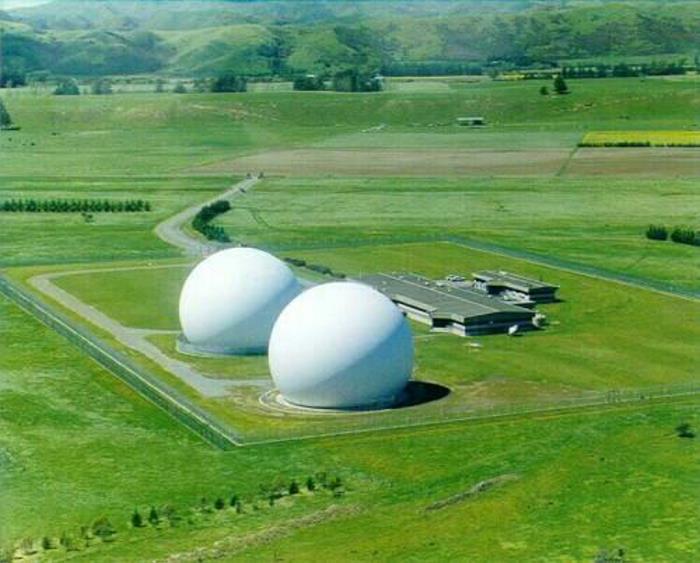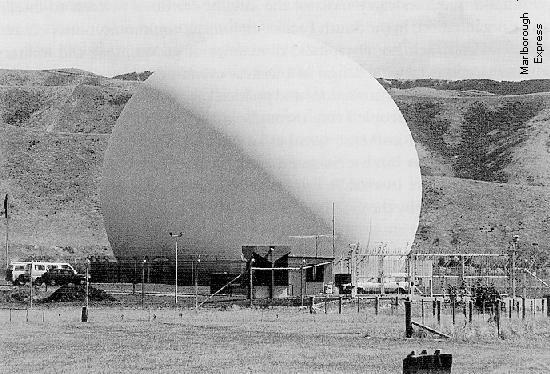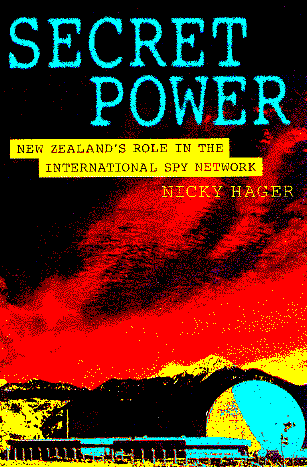|
|
||||
|
New Zealand Code Name: Flintlock -41° 34' 36.00", +173° 44' 20.00" ..
New Zealand's Government Communications Security Bureau operates what it describes as a satellite communications monitoring facility in the Waihopai Valley. First announced in 1987, the facility has been identified by MP Keith Locke as part of ECHELON, the worldwide network of signals interception facilities run by the UKUSA consortium of intelligence agencies (which shares global electronic and signals intelligence among the Intelligence agencies of the US, UK, Canada, Australia and NZ). Operations It contains two satellite interception dishes (shielded by giant domes). Few details of the facility are known, but it is believed that it intercepts and processes all phone calls, faxes, e-mail and computer data communications. It is thought that this data is then sorted and shared with the other members of the UKUSA group. The Waihopai station is a sister operation to a similar facility run at Tangimoana Protests and security breaches One of the domes collapsed after the 2008 Ploughshares attack. The site is a regular target for protesters and activists who are attempting to have the base closed down. The Anti-Bases Campaign have had regular yearly protests at the base. In 1996 Nicky Hager entered the base at night with John Campbell and a TV3 film crew, and managed to film the operations room through a window. Hager returned in 1999 with Mikey Havoc and Jeremy Wells (as his "Newsboy" persona). They sneaked into the base and danced in front of cameras for a television show in which Havoc and Newsboy were starring. In April 2008 Ploughshares Aotearoa or Anzac Ploughshares breached three security fences to enter the base and then used a sickle to deflate the kevlar covering over one of the two satellite dishes. Prime Minister Helen Clark condemned the attack on the spy base as a "senseless act of criminal vandalism". The Waihopai station is a sister operation to a similar facility run at Tangimoana. SOURCE: Wikipedia |
||||
|
||||
|
..
Spy base attackers in court
Three peace activists, accused of deflating one of Waihopai spy base's domes with sickles today, have been remanded in custody on criminal damage and burglary charges. But police told Blenheim District Court they were considering charging the men with sabotage under the Crimes Act, an offence which carries a maximum sentence of 10 years' jail. Damage to the Marlborough base, run by the Government Communications Security Bureau (GCSB), is estimated at more than $1 million. Samuel Peter Frederick Land, 24, of Hokianga, Adrian James Leason, 42, a teacher from Otaki and Peter Reginald Leo Murnane, 67, a Dominican friar from Auckland, have all been charged with intentionally damaging a satellite dish, the property of the GCSB, and entering a building with the intention to commit a crime. At today's bail hearing, Judge Richard Russell remanded Leason and Murnane in custody without plea to reappear in court on Monday. Land's bail application was adjourned until Monday and he was also kept in custody. The three men were arrested early this morning, after allegedly using bolt cutters to cut through three security fences and one of two 30-metre domes covering satellite interception dishes was deflated. SOURCE and Rest of Article: Stuff.co.nz/4503358a10.html ..
|
||||
|
..
...
...
... |
||||
|
New Zealand's Role in the International Spy Network ..
New Zealand's Role in the International
Spy Network
Chap 2: Hooked up to the spy network: The UKUSA system Ten years later, on Saturday, 15 January 1994, technicians in satellite earth stations around the Pacific were busy tuning their equipment to a new satellite. The first of the new generation of Intelsat 7 series satellites, it had been launched several weeks before, from the European Kourou air base in French Guyana, and then manoeuvred into position far out in space above the Equator at 174 degrees east, due north of New Zealand above Kiribati. The 20 Intelsat (International Telecommunications Satellite Organisation) satellites that ring the world above the Equator carry most of the world's satellite-relayed international phone calls and messages such as faxes, e-mail and telexes. The new satellite, Intelsat 701, replaced the 10-year-old Intelsat 510 in the same position. The changeover occurred at 10 pm New Zealand time that summer evening. At the GCSB's station at Waihopai, near Blenheim in the north of the South Island, the radio officer staff were just as busy that evening, setting their special equipment to intercept the communications which the technicians in legitimate satellite earth stations would send and receive via the new satellite. These specially trained radio officers, who learned their skills at the Tangimoana station, usually work day shifts, but on 15 January 1994 they worked around the clock, tuning the station's receivers to the frequency bands the GCSB wanted to intercept, selecting the specific channels within each band that would yield the types of messages sought within the UKUSA network and then testing that the high-tech intelligence collection system was working smoothly. That satellite changeover was a very significant event for the Waihopai station and the GCSB. Although it would always be only a small component of the global network, this was the moment when the station came into its own. There have been various guesses and hints over the years about what the Waihopai station was set up to monitor -- "sources" in one newspaper said foreign warship movements; a "senior Telecom executive" told another newspaper it was most likely "other countries" military communications" -- but, outside a small group of intelligence staff, no one could do more than theorise. Waihopai was established specifically to target the international satellite traffic carried by Intelsat satellites in the Pacific region and its target in the mid-1990s is the Intelsat 701 that came into service in January 1994, and is the primary satellite for the Pacific region. Intelsat satellites carry most of the satellite traffic of interest to intelligence organisations in the South Pacific: diplomatic communications between embassies and their home capitals, all manner of government and military communications, a wide range of business communications, communications of international organisations and political organisations and the personal communications of people living throughout the Pacific. The Intelsat 7 satellites can carry an immense number of communications simultaneously. Where the previous Intelsat 5s could carry 12,000 individual phone or fax circuits at once, the Intelsat 7s can carry 90,000. All "written" messages are currently exploited by the GCSB. The other UKUSA agencies monitor phone calls as well. SOURCE and Rest of Article: |
||||
| Government Communications Security
Bureau [GCSB]
Updated Saturday, July 11, 1998 4:21:16 PM The mandate of the Government Communications Security Bureau [GCSB] is to satisfy the foreign intelligence requirements of the NZ Government. The focus of its intelligence activities is restricted to foreign intelligence. GCSB collects, assesses, produces reports and disseminates foreign intelligence to meet the national foreign intelligence requirements of the New Zealand Government and its agencies. It also has subsidiary functions which assist its collection capability by signals research identification and analysis of signal sources and devices. Collection is made from electronic communication transmitted through satellite, radio waves or other open means. GCSB does not intercept private or other communication transmitted by telephone land lines. GCSB operates a satellite monitoring station at Waihopai near Blenheim and a radio receiving station at Tangimoana near Foxton. These are both capable of receiving and collecting foreign intelligence. The equipment is equally capable of receiving signals transmitted by radio and satellite which do not include foreign intelligence and which are domestic concerning and involving NZ citizens. Government initiatives announced in 1997 to enhance the foreign signals intelligence collection capability of the GCSB include constructing a second antenna at Waihopai and to extend the authority of the GCSB to collect foreign voice communications. The latter was attended to by the making of the Crimes (Exemption of Listening Device) Order 1997. That exempted the GCSB's station at Waihopai from the provisions of Part IX.A of the Crimes Act 1961 for the purpose only of intercepting foreign voice communications containing foreign intelligence. Through the UK-USA agreements, GCSB has links with the National Security Agency US, Communications Security Establishment Canada, Defence Signals Directorate Australia and the Government Communications Headquarters United Kingdom. Sources and Methods:
Maintained by Steven Aftergood |
||||
|
||||
| FAIR USE NOTICE: This page contains copyrighted material the use of which has not been specifically authorized by the copyright owner. Pegasus Research Consortium distributes this material without profit to those who have expressed a prior interest in receiving the included information for research and educational purposes. We believe this constitutes a fair use of any such copyrighted material as provided for in 17 U.S.C § 107. If you wish to use copyrighted material from this site for purposes of your own that go beyond fair use, you must obtain permission from the copyright owner. | ||||
|
|










